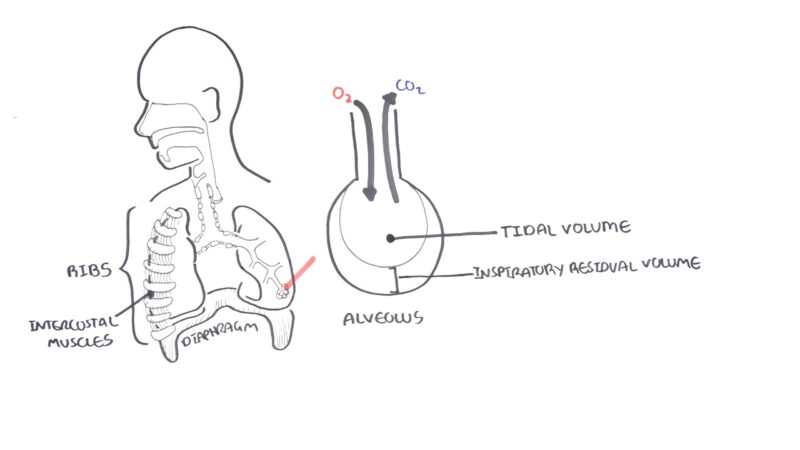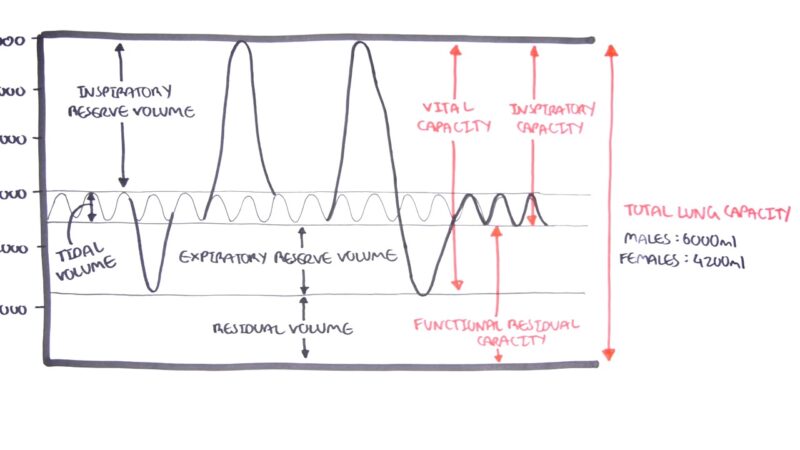Have you ever stopped to think about the incredible role your lungs play in keeping you healthy and thriving? Well today, we will talk about lung volumes and discover just how they impact your overall well-being.
We’ll also explore the intricate mechanisms behind lung volumes and why they matter more than you might realize. Let’s get started.
Lung Volumes
1. Tidal Volume (TV)

Imagine a calm sea with waves gently lapping the shore. The Tidal Volume is similar to these waves, representing the volume of air we breathe in and out during normal breathing at rest.
2. Inspiratory Reserve Volume (IRV)

Imagine IRV as that refreshing intake of air you savor before plunging into a pool. It’s like that additional breath you can draw in, surpassing your regular breathing capacity, as you inhale deeply.
3. Expiratory Reserve Volume (ERV)

Imagine yourself after a satisfying jog, as you take a moment to recover and regain your breath. ERV, or Expiratory Reserve Volume, embodies the remarkable ability of your lungs to release even more air beyond what is normally exhaled with each breath, showcasing their remarkable capacity for maximum exhalation.
Expiratory reserve volume is the amount of extra air above normal that you exhale during a forceful breath out. ERV is part of the data gathered in pulmonary function tests used to diagnose restrictive pulmonary diseases and obstructive lung diseases. – Scott Frothingham
4. Residual Volume

Did you know that even when you think you’ve breathed out all the way, there’s still a little bit of air hanging out in your lungs? We call this the Residual Volume. It’s a bit elusive because you can’t really measure it directly using spirometry. Advanced techniques are required to determine this parameter.
According to John J. Lofrese, the residual volume (RV) refers to the amount of air that stays in the lungs following a maximum forceful exhale. Essentially, it is the air volume that cannot be removed from the lungs, ensuring that the alveoli remain open continuously.
5. Forced Expiratory Volume (FEV)
Picture yourself blowing out the flickering candles on a birthday cake with a gentle gust of air. FEV, which stands for Forced Expiratory Volume, measures how much air you can exhale forcefully within a mere second.
The FEV/FVC ratio, where FVC represents Forced Vital Capacity, plays a vital role in diagnosing various conditions. In a well-functioning lung, this ratio typically hovers around 0.8, implying that approximately 80% of the total FVC is expelled within the initial second.
Nevertheless, this ratio can serve as an indicator of the presence of Obstructive or Restrictive Lung Diseases, offering valuable insights into one’s respiratory health.
The Combinations Of Lung Capacities

1. Vital Capacity (VC)
VC represents the total volume of air you can breathe in and out when pushing your lungs to their limits. Derivation: VC = IRV + TV + ERV
2. Forced Vital Capacity (FVC)
FVC is the volume of air you can exhale forcibly after a deep inhalation. While it should ideally match the VC, the term ‘forced’ indicates the nature of the exhalation. The time taken to reach FVC is diagnostic, especially when paired with FEV.
3. Functional Residual Capacity (FRC)
After a regular breath, the air that remains in our lungs is the FRC. Derivation: FRC = ERV + Residual Volume
4. Total Lung Capacity (TLC)
TLC is the grand total, the maximum volume of air our lungs can hold. It’s a sum of all the volumes, but can’t be directly measured using spirometry due to the inclusion of the Residual Volume. Derivation: TLC = VC + Residual Volume







